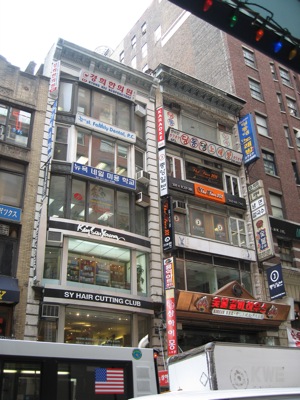Koreatown: Economy
From Decoding New York
| Introduction |
| Little Italy |
| * Evolution |
| * Here v. There |
| * Economy |
| * What's Real |
| Koreatown |
| * Evolution |
| * Here v. There |
| * Economy |
| * What's Real |
| Comparison |
| * Photo Gallery |
| * Sources
|
The booming economy of Koreatown is the source of life for the neighborhood. From its beginnings,, business has been growing exponentially. Restaurants, malls, hotels, clubs and small businesses are the main attractions for the visitors and therefore are the main contributors to its capital. The great location in midtown, right next to such tourist hot spots as Times Square, the Empire State Building, Herald Square, and Madison Square Garden, and many subway lines and Penn Station, brings Koreatown to the a stronger economic position. New large business corporations and high-class restaurants and hotels grow like mushrooms after the rain. This economic growth is almost like a “monopoly,” explains an owner of a small business. He says that big businesses take over the small ones; the competition for the place is fierce causing the renting price to go even higher. Despite this economic change, one can still find small shops that were the trailblazers in the development of Koreatown. These pioneering businesses are still alive today because most of them are family businesses that were inherited and passed down from generation to generation. The highly detailed map of Koreatown shows just how densely filled this area is with its great variety of businesses categorized into six groups: dining, cafes, bars/lounges, hotels, art galleries, shopping, spas/hair salons, and services. No wonder people continue to flock to Koreatown – this place has absolutely everything to satisfy the most finicky customer.
A map of businesses in Koreatown: http://mondomap.com/mondo/index.cfm?bid=154
